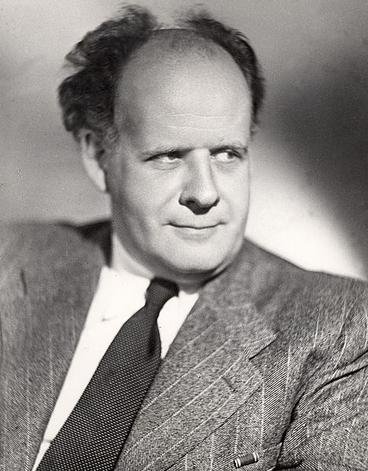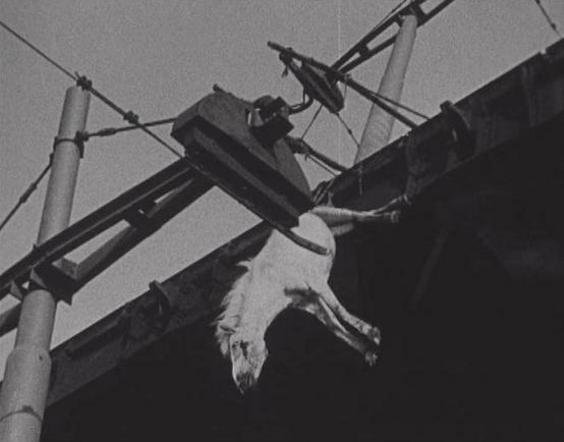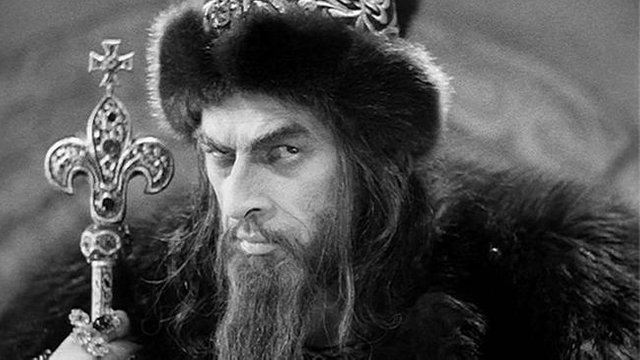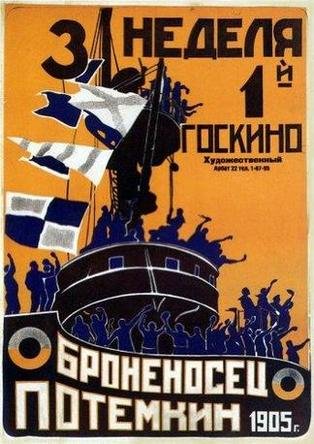ADSactly Cinema: Filmmakers and essential films: Sergei Eisenstein and *The Battleship Potemkin*

Filmmakers and essential films:
Sergei Eisenstein and The Battleship Potemkin
Filmmakers and essential films:
Sergei Eisenstein and The Battleship Potemkin
Dear readers, in the continuation of the series about film directors and their indispensable film work, following a certain chronological order, I dedicate this post to one of the greats of the seventh art: the Russian filmmaker Sergei Eisenstein, who went down in history for the mastery of his achievements and his contributions in the cinematographic montage. Particularly, we will stop at one of his films, The Battleship Potemkin.
Life and work
Sergei Eisenstein was born in Riga, Latvia, in 1898, and died in 1948, in Moscow. He had Jewish ancestry on his father's side, and bourgeois ancestry on his mother's side. In addition to film director, he was a theorist and writer, producer, art director, production designer, set designer and actor. He studied architecture and art, and had a penchant for painting. He participated in the October Revolution of 1917. He soon joined the world of show business, making sets and directing and performing theater. While shooting his first feature film The Strike in 1924, he was commissioned a film to commemorate the origins of the revolution and made his masterpiece The Battleship Potemkin, with which he decisively influenced the development of cinematographic art.
In 1927 he filmed October, which was intended to be the reconstruction of the events of 1917, based on the book Ten Days that Shook the World, by John Reed (by the way, there is a film entitled Reds about this writer, directed and acted by Warren Beatty), and in which he applied his cinematographic ideas. It was censored because its view of historical facts did not coincide with the official view of the Communist Party. He was forced to eliminate three quarters of an hour because Trotsky - one of the three historical characters - had fallen into disgrace.

In 1930, Eisenstein went to Europe and America, specifically to the United States and Mexico. His Hollywood projects were rejected by a communist. In Mexico, he began filming Long live Mexico!, in 1931, a film that did not finish.
He returned to Moscow, where his cinematographic projects were obstructed, because his ideas were rejected in the high levels of the regime. He then devoted himself to teaching and writing.
Overwhelmed by political limitations, he proposed to film The Meadow of Bezhin, in 1937, based on a tale by Ivan Turguénev, which was banned and not exhibited.
He went ahead and made in 1938 Alexander Nevsky, his first sound film, which presents the fight of the Russians against the Teutonic knights in the 11th century. In 1944 the first part of Iván el Terrible was completed, in which the ascension to power as tsar, in the 16th century, of Ivan IV and the betrayal suffered by him is recounted. When the assembly of the second part of Ivan the Terrible, which told of his revenge, was finished, Eisenstein suffered a serious heart attack. It was banned for ten years and premiered after Stalin's death.

Valuation
Although Eisenstein, at various points in his career, complied with the interests of the leaders of the Soviet regime, his creative work -as is often the case in the relationship between artist and power- annoyed many of his personeros; his productions were often seen as an expression of a confused and disparate vision, "formalist" because of his poetic interpretation of reality and history.
Although his works may suffer from ups and downs, which is characteristic of any artist who explores in his art, he came to have, like few others, a clear awareness of his quest and of the psychological effect of the image. There were many sources of her brilliant intellectual formation (where the works of the German Fritz Lang, the American David Griffith, the Russian Dziga Vertov and Lev Kuleshov stand out) that influenced in the elaboration of her theory and cinematographic practice. As Sadoul acknowledges:
Eisenstein was convinced that in cinema he could manipulate time and space to create new meanings, especially if the images were not simply linked, but dislocated and juxtaposed.
He has been recognized as the first great theoretician of cinema and as one of the fathers of the art of editing (what some call today "editing").
The art of editing

When the cinema had only a few decades of development, Eisenstein formulates his theory of montage, defined by him as "a combination of shots that are representative, unique in their meaning, neutral in their content, in intellectual contexts". In his model he proposes techniques that would be applied by the filmmakers who succeeded him, up to the present day, beyond today's sophisticated technology.
According to Enrique Martínez-Salanova,
Eisenstein managed to understand before his contemporaries that the montage of films was not only to chain some scenes with others, but an element capable of reaching the spectator to manipulate his emotions.
First of all, he proposed a new cinematographic form: the "montage of attractions", in which the arbitrarily selected images would be presented not in chronological sequence, but in a form that would create maximum psychological impact. This technique will be used in The Strike, using expressionist camera angles as well as bold visual metaphors. For example, he juxtaposed images of cows slaughtered in a slaughterhouse with workers being injured by the army.
He formalized five types of montage (which we cannot develop here): a) metric montage; b) rhythmic montage; c) tonal montage; d) harmonic montage, and e) intellectual montage.
To learn about these five types of assembly, you can visit the following video in English, or download the following file pdf in Spanish.
This is very relevant, because much of the progress that has been made in the art of film is due to editing, to the extent that someone said that our current cinema was mainly a product of that.
The battleship Potemkin

As we said, the film The Battleship Potemkin is not only considered as Eisenstein's main work, but, even more, a milestone in the universal history of cinema. That's why it's essential in our cinematographic and cultural training in general.
Based on real events, the film presents the mutiny that occurred in the battleship Potemkin in 1905, when sailors rose up against the officers of the tsarist navy, deciding not to endure mistreatment and corrupted food, on the one hand, and the acts of bloody repression of the army in the face of the united and determined reaction of the relatives and inhabitants in the port of Odessa, on the other.
To a certain extent, it is a kind of reconstructed news item. It was filmed in a few weeks, and few actors, city people and soldiers participated in it. He discarded studies, make-up and scenography. The great actor is the mass. They were two collective characters: the sailors of the battleship and the population of the city.
(You can see the film in this link)
The stairs of Odessa
As film critics have indicated, the climax of The Battleship Potemkin is the well-known part of the Odessa staircase, when the army fires on innocent people to extinguish support for the rebellion. Using images carefully photographed and framed by Tissé, Eisenstein puts into practice his thesis of montage (particularly, the use of rhythmic montage and tonal) and reaches a sequence of dramatic moments, with great psychological effect. I quote Sadoul's description:
The multitude is individualized by very close-ups of faces or details of attitudes or garments, chosen with an unequalled sense of characterization. (...) living models alternate with expressive objects: boots, a ladder, a fence, a sabre, a stone lion. And the episode is marked by violent, heartbreaking attractions: the mother carrying the corpse of her son, the baby carriage descending only the stairs, the bursting, bleeding eye, behind the steel-rimmed glasses.

In this sequence Eisenstein immortalized one of the greatest situations of emotion, effectiveness and tension in cinema. It was based on real events but modified them, and created a story that, although fiction, has been repeated several times in the dramatic history of peoples. He achieved in his time and still now that the spectators are impressed in the use of filming and editing, the realization of an idea through the metaphorical expression that, as Enrique Martínez S. points out, "has allowed us to "really" capture through fiction the reality of a story that never existed but is always existing.
Parts of that sequence can be seen at the following link)
Bibliographic references
Sadoul, Georges (2004). History of World Cinema (19th ed.). Mexico: Edit Siglo XXI.
Le Choismier, Christophe. Sergei Mikhaylovich Eisenstein. Document online: https://web.archive.org/web/20120305160156/http:/www.videoartworld.com/beta/artist_422.html
Martínez-Salanova, Enrique. Sergei M. Eisenstein. Document online: http://educomunicacion.es/cineyeducacion/figuraseisenstein.htm
https://en.wikipedia.org/wiki/Sergei_Eisenstein
https://en.wikipedia.org/wiki/Battleship_Potemkin
Written by @josemalavem
Click on the coin to join our Discord Chat

Witness proposal is here:
Go To Steem Witness Page
In the bottom of the page type: adsactly-witness and press vote.

Use small letters and no "@" sign. Or, click here to vote directly!
Thank you!
Hi @josemalavem. Fantastic! You make a truly meticulous article with the presentation of an indispensable filmmaker for movie lovers. Sergei Eisenstein and The Battleship Potemkin is a film that we should see once and I'm sure we would see it 2 or 3 times later to discover details that would go unnoticed at first glance.
The stairs of Odessa is my favorite part because there is the whole Theory of montage up to that time. Only that part is a masterpiece. And, in addition, The stairs of Odessa have been honored in other times by several filmmakers. Even in animation movies.
A fact that I do not know if you can confirm me. Even though The Battleship Potemkin is based on real events, I once read that the use of a white sheet covering the sailors, at the end of the film, before their execution, it was a recreation of Eisenstein since that fact never happened.
Excellent choice to start a film tour of filmmakers and essential films. Best regards @josemalavem
Hello, @marcybetancourt. Nice to have you as a reader.
Some scholars say that although the film was based on real facts, not everything happened as it is presented. Some even doubt that there was the mass murder on the stairs linked to the battleship mutiny. Also that the victorious end does not coincide with what happened historically, that the sailors were imprisoned and condemned to death. That's why the commentary and the quote from the end.
This is the second post in this series (the first was about Fritz Lang and Metropolis (see here), which I will alternate and dose with the series of literature. Thank you for your eyesight.
Very informative. I haven’t really watched any movies shot in the late 1800s or early 1900s.
I have to go and read more on Ivan the terrible because I have come across it some where.
Very interesting read
Posted using Partiko iOS
Thank you for your reading. If you are interested in having an education about the evolution of cinema or enjoying it as a cinephile, you should get to know foundational films, such as this one by Eisenstein. Greetings, @chiama.
Thank you
Posted using Partiko iOS
Wow. That was a great read. Thank you ! Upvoted and follow!!
Posted using Partiko iOS
Thank you for your reading and assessment.
Nice post @adsactly
Hi, @adsactly!
You just got a 0.33% upvote from SteemPlus!
To get higher upvotes, earn more SteemPlus Points (SPP). On your Steemit wallet, check your SPP balance and click on "How to earn SPP?" to find out all the ways to earn.
If you're not using SteemPlus yet, please check our last posts in here to see the many ways in which SteemPlus can improve your Steem experience on Steemit and Busy.
@josemalavem, Direction is the Backbone of any movie and any mistake on this part then in a way movie is destroyed in that spot only.
And it's always great to see the journey of Direction and every journey hold a lesson and can inspire for sure. And movie world is one world which will always leave behind great memories.
Posted using Partiko Android
Thanks for your comment, @chireerocks.
Welcome.
I remember watching this movie a couple of times and there are always scenes that impress me. As @marcybetancourt said, the most memorable scene of the Battleship Potemkin is the scene of the Odessa staircase where the army charges against the people and we see the massacre of the citizens. But certainly this scene never really happened and was a complete invention of Eisenstein, However, the influence of the film has been so great that many people have claimed that the massacre of the staircase really existed. Eisenstein
is remembered for the great advances he made in editing (there are even some who qualify him as the best) and The Battleship Potemkin as one of the best films in history. Excellent series, @josemalavem